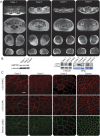Muscle involvement in limb-girdle muscular dystrophy with GMPPB deficiency (LGMD2T)
- PMID: 27766311
- PMCID: PMC5061416
- DOI: 10.1212/NXG.0000000000000112
Muscle involvement in limb-girdle muscular dystrophy with GMPPB deficiency (LGMD2T)
Abstract
Objective: In this study, muscle involvement assessed by MRI and levels of GMPPB and glycosylation of α-dystroglycan expression in muscle were examined in patients with limb-girdle muscular dystrophy (LGMD) type 2T.
Methods: Six new patients with genetically verified mutations in GMPPB were studied. T1-weighted magnetic resonance images were obtained in 4 participants. Muscle strength and potential involvement of extramuscular organs were examined. Glycosylation of α-dystroglycan in muscle was studied, and GMPPB and α-dystroglycan expression was analyzed by Western blotting. Prevalence of LGMD2T was calculated from the total LGMD population in Denmark. GMPPB was sequenced in all unclassified cases.
Results: Two patients carried 3 new mutations in GMPPB. The other 4 patients carried previously described pathogenic mutations in GMPPB. MRI showed that the paraspinal muscles were the most affected, followed by involvement of hamstrings. Our results showed a loss of glycosylation of α-dystroglycan as well as secondary loss of merosin expression on Western blotting. The prevalence of LGMD2T in the Danish cohort of patients with LGMD is 1.5%.
Conclusions: The new findings of this study are (1) the consistent finding of a preferential affection of paraspinal and hamstring muscles in LGMD2T, (2) 3 new mutations in GMPPB, (3) variable loss of glycosylation tested with IIH6 and VIA4 antibodies, and (4) a prevalence of LGMD2T of 1.5% in a well-characterized Danish LGMD cohort.
Figures


References
-
- Cabrera-Serrano M, Ghaoui R, Ravenscroft G, et al. . Expanding the phenotype of GMPPB mutations. Brain 2015;138:836–844. - PubMed
LinkOut - more resources
Full Text Sources
Other Literature Sources
